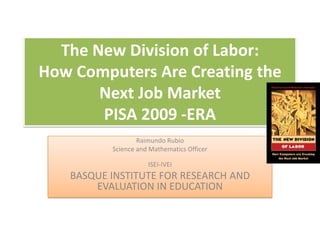
The New Division Of Labor -PISA 2009 - ERA
- 1. The New Division of Labor: How Computers Are Creating the Next Job Market PISA 2009 -ERA Raimundo Rubio Science and Mathematics Officer ISEI-IVEI BASQUE INSTITUTE FOR RESEARCH AND EVALUATION IN EDUCATION
- 2. ON MARCH 22, 1964, THE AD HOC COMMITTEE ON THE TRIPLE Revolution sent a fourteen-page memorandum to President Lyndon Johnson The signers included chemist Linus Pauling (recipient of two Nobel Prizes), economist Gunnar Myrdal (a future Nobel Prize-winner), and Gerard Piel, publisher of Scientific American.
- 3. A new era of production has begun • Its principles of organization are as different from those of the industrial era as those of the industrial era were different from the agricultural. • The cybernation revolution has been brought about by the combination of the computer and the automated self-regulating machine. • This results in a system of almost unlimited productive capacity which requires progressively less human labor. • Cybernation is already reorganizing the economic and social system to meet its own needs.
- 4. It involves rethinking education and training, beginning with answering four fundamental questions: • What kinds of tasks do humans perform better than computers? • What kinds of tasks do computers perform better than humans? • In an increasingly computerized world, what well-paid work is left for people to do both now and in the future? • How can people learn the skills to do this work?
- 5. In 1970, more than one-half of employed U.S. adults worked in two broad occupational categories: • blue-collar jobs and clerical (white)jobs • Few people got rich in these jobs, but they supported middle- and lower-middle-class living and many were open to high school graduates. • Today, less than 40 percent of adults have blue- collar or clerical jobs and many of these jobs require at least some college education. • The computerization of work has played a significant role in this change.
- 6. In the past, when new technologies have replaced workers in a given sector, new sectors have always emerged to absorb the displaced laborers • Today, all three of the traditional sectors of the economy-- agriculture, manufacturing, and service--are experiencing technological displacement, forcing millions onto the unemployment rolls. • The only new sector emerging is the knowledge sector, made up of elite entrepreneurs, scientists, technicians, computer programmers, professionals, educators, and consultants. • While this sector is growing, it is not expected to absorb more than a fraction of the hundreds of millions who will be eliminated in the next several decades in the wake of revolutionary advances in the information and communication sciences.
- 7. VARITIES OF HUMAN INFORMATION PROCESSING Conscious Application of Rules Cannot be Application of Inductive Rules Articulated Deductive Rules (Rules- Based Logic) (Pattern Recognition) (Pure Pattern Recognition) Arithmetic, Predicting a Mortgage Writing a Legal Brief, Default Boarding Pass a Truck Driver making a Recognizing left turn against traffic. Recognizing a Spoken Name
- 9. What Skills are Now Required? Expert Thinking: Solving problems for which there are no rule-based solutions. Examples : •Diagnosing the illness of a patient whose symptoms seem strange •Creating a good tasting dish from the ingredients that are fresh in the market that morning •Repairing an auto that does not run well but that the computer diagnostics report has no problem. These problems require what we have called pure pattern recognition – information processing that cannot now be programmed on a computer.
- 10. Complex Communication: Interacting with humans to acquire information, to explain it, or to persuade others of its implications for action. Examples: •Manager motivating the people whose work she supervises •A sales person gauging a customer’s reaction to a piece of clothing, •A biology teacher explaining how cells divide, •An engineer describing why a new design for a DVD player is an advance over previous designs.
- 11. Routine Cognitive Tasks. Mental tasks that are well described by deductive or inductive rules. Examples: • Maintaining expense reports •Filing new information provided by insurance customers •Evaluating applications for mortgages. Because these tasks can be accomplished by following a set of rules, they are prime candidates for computerization.
- 12. Routine Manual Tasks. Physical tasks that can be well described using deductive or inductive rules. Examples: •Installing windshields on new vehicles in automobile assembly plants •Counting and packaging pills into containers in pharmaceutical firms. Since these tasks can be defined in terms of a set of precise, repetitive movements they are also candidates for computerization.
- 13. Non-routine Manual Tasks: Physical tasks that cannot be well described as following a set of If-Then-Do rules because they require optical recognition and fine muscle control that have proven extremely difficult to program computers to carry out. Examples: •driving a truck •cleaning a building •setting gems in engagement rings. Computers do not complement human effort in carrying out most such tasks. As a result, computerization should have little effect on the percentage of the workforce engaged in these tasks.
- 14. Figure 3: Economy-Wide Measures of Routine and Non-Routine Task Input: 1969 - 1998 (1969 = 0) (pag . 14) Routine manual Mean task input as percentiles of the 1960 task distribution 65 60 Nonroutine manual 55 Routine cognitive 50 Nonroutine analytic 45 40 Nonroutine interactive 1960 1970 1980 1990 2002 (Levy y Murnane)
- 15. Secondary graduation number in the future 14.000.000 12.000.000 10.000.000 8.000.000 2003 2010 6.000.000 2015 4.000.000 2.000.000 0 China EU India US
- 16. PISA 2009 -Electronic Reading Assessment Reading of electronic texts is becoming increasingly necessary and prevalent in society. PISA recognises this and has integrated the reading of electronic texts into the PISA 2009 Reading Framework. The Electronic Reading Assessment (ERA) is an innovative Electronic Reading Assessment project aiming at assessing the reading literacy of 15-year-olds using electronic texts. It is an international option in PISA 2009. ERA is a 30-minute test using existing school IT infrastructure. http://erasq.acer.edu.au/ Username: public Password: access.